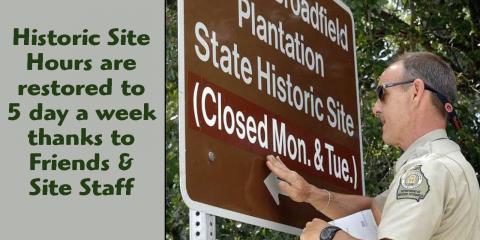
--Submitted by: Jim Hite, Friends of Magnolia Springs Chapter President
 Construction is well underway on The History Center at Magnolia Springs State Park with goals to open the first phase of the building in late fall or early winter of this year.
Construction is well underway on The History Center at Magnolia Springs State Park with goals to open the first phase of the building in late fall or early winter of this year.
David Clark, chief of engineering and construction, Georgia Department of Natural Resources, Parks Division, said that the project will be more than a museum, thus the name "History Center."
Plans for The History Center began when Georgia DNR Commissioner Chris Clark, a 1992 graduate of GSU, wanted to re-ignite interest in Magnolia Springs State Park, after experiencing particular economic hardships in the recession. Clark asked anthropology professor, Dr. Sue Moore, to see what could be done. Together with graduate student, Kevin Chapman, and several others, Moore's team was soon convinced that Magnolia Springs State Park was the perfect location for a fantastic service and thesis project. Known as Camp Lawton (also known as "the world's largest prison") during the Civil War, Magnolia Springs has a deep, untouched history waiting to be discovered.
 With that, the work began in 2010. On their first day of excavation, a button and cut musket ball were found, and, shortly after, a large US. Cent dated before the Civil War was found. The site had been mostly undisturbed since its abandonment after the Civil War with the exception for the building of the state park and a fish hatchery by the CCC in the 1930s. Archaeological treasures beyond anyone's imagination have been uncovered and the work is expected to continue indefinitely.
With that, the work began in 2010. On their first day of excavation, a button and cut musket ball were found, and, shortly after, a large US. Cent dated before the Civil War was found. The site had been mostly undisturbed since its abandonment after the Civil War with the exception for the building of the state park and a fish hatchery by the CCC in the 1930s. Archaeological treasures beyond anyone's imagination have been uncovered and the work is expected to continue indefinitely.
The first phase of construction of Magnolia Springs' History Center will house these Civil War artifacts uncovered at the site of Camp Lawton. Presently, the artifacts are on display at the GSU museum. Plans for The History center are well underway and include exhibit areas, a public theater space, an archaeological lab, and a computer research area. The active archaeological lab will hold areas for public viewing and interaction and the computers will also be available to visitors for researching databases. The next stage of planning includes a walking trail around the perimeter of the Camp Lawton site.
 Architect Karen Sicner, in describing the "Master Plan" last fall explained, "It will take several years to complete."
Architect Karen Sicner, in describing the "Master Plan" last fall explained, "It will take several years to complete."
The development is a partnership between the Andersonville prison site and Camp Lawton.
Camp Lawton was constructed in late 1864 by the Confederate Army to replace Andersonville and housed more than 10,000 Union prisoners as well as hundreds of Confederate soldiers. But, as Sherman's troops approached Millen in late November, 1864, the prisoners were evacuated and the site abandoned.
Visit Friends of Magnola Springs State Park on the web by clicking HERE or find them on FACEBOOK.